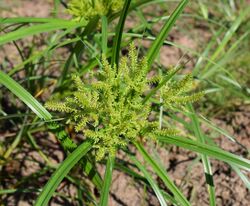Biology:Cyperus erythrorhizos
| Redroot flatsedge | |
|---|---|

| |
| Scientific classification | |
| Kingdom: | Plantae |
| Clade: | Tracheophytes |
| Clade: | Angiosperms |
| Clade: | Monocots |
| Clade: | Commelinids |
| Order: | Poales |
| Family: | Cyperaceae |
| Genus: | Cyperus |
| Species: | C. erythrorhizos
|
| Binomial name | |
| Cyperus erythrorhizos Muhl.
| |
| Synonyms[1] | |
| |
Cyperus erythrorhizos is a species of sedge known by the common names red-rooted flatsedge[2] or redroot flatsedge.[3] It is found across much of North America from Maine, Ontario[2][1] and British Columbia[4] south to Tabasco in southern Mexico.[5][6][7][8]
Cyperus erythrorhizos is a plant of wet areas such as rivers and ditches, generally at low elevations. It gets its common and scientific names from the red color of its roots. This sedge grows to a maximum of a meter in height, but is usually quite a bit shorter. It may have a number of long, wispy leaves around the base of the plant. The inflorescence may contain one to several spikes, each spike containing 20 to over 100 spikelets. Each spikelet is light greenish brown to reddish brown and is made up of up to 30 bracted flowers. The fruit is a glossy achene about a millimetre long.[2]
See also
References
- ↑ 1.0 1.1 Kew World Checklist of Selected Plant Families
- ↑ 2.0 2.1 2.2 Flora of North America, Vol. 23 Page 172, Cyperus erythrorhizos Muhlenberg, Descr. Gram. 20. 1817.
- ↑ USDA Plants Profile
- ↑ Douglas, G.W., Meidinger, D. & Penny, J.L. (2002). Rare Native Vascular Plants of British Columbia, ed. 2: 1-358. Province of British Columbia.
- ↑ Novelo, A. & L. Ramos. 2005. Vegetación acuática. Cap. 5: 111–144. In J. Bueno, F Álvarez & S. Santiago. Biodiversidad del Estado de Tabasco. CONABIO-UNAM, México.
- ↑ Pérez J., L. A., M. Sousa Sánchez, A. M. Hanan-Alipi, F. Chiang Cabrera & P. Tenorio L. 2005. Vegetación terrestre. 65–110. In J. Bueno, F Álvarez & S. Santiago. Biodiversidad del Estado de Tabasco. CONABIO-UNAM, México.
- ↑ Tucker, G. C. 1994. Revision of the Mexican species of Cyperus (Cyperaceae). Systematic Botany Monographs 43: 1–213.
- ↑ Espejo Serna, A. & López-Ferrari, A.R. (1997). Las Monocotiledóneas Mexicanas una Sinopsis Florística 5: 1-98. Consejo Nacional de la Flora de México, México D.F.
External links
Wikidata ☰ Q5200202 entry
 |

